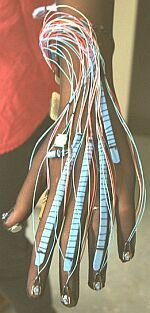

Using electronic musical instrument design techniques for measuring behavior
A.J. Bongers
Metronom Electronic Arts Studio, Barcelona, Spain
Introduction
Musical instruments have a long history of development as the most sensitive
artefacts for human expression. Electronic musical instruments, developed in
the last century, are no exception. In the field of the electronic arts, examples
can be found of human interfaces that are extremely sensitive and precise, enabling
the artist to have profound and intimate control over the complex processes
inside the computer. These instruments and interaction technologies can be used
for measuring human behaviour in fields other than the electronic arts. To measure
human behaviour, there are three broad categories of relevant machine factors:
In this presentation, I will give some examples ranging from interactive archi-tecture to electronic musical instruments I have developed with pioneers in the field, such as Laetitia Sonami, "The Lady's Glove" (Figure 1(left)) and Michel Waisvisz, "The Hands" (Figure 1(right)) and the Sensorband's "Soundnet" (Figure 2). I will also describe the structured design approach, as applied in a recent project to produce an instrument for the live performance of audio and visual material ("The Video-Organ").


Figure 1. (left) Laetitia Sonami's "Lady's Glove" (1994), (right) One of Michel Waisvisz's "Hands" (1991).

Figure 2. The sensorband on the "Soundnet" (1998).
Crossover
During the
talk, some examples will be given of how technologies and techniques from the
electronic arts field may be used in psychometric experiments:
Investigating the parallel use of the sense of touch in multimodal human-computer interaction: a research project I carried out at the UCL and Birkbeck Colleges of the University of London. An experiment was designed and performed using (in addition to standard loudspeakers and screens): purpose built switch units, a tactile feedback device, and the Max/MSP software (to generate the auditory, visual and haptic stimuli, in random and structured order, as well as measuring and logging the response times).
The occurrence of a central processing bottleneck in human cognition when carrying out a multimodal task was investigated through the measurement of the PRP-effect (Psychological Refractory Period, referring to the measurable slowing of responses under certain conditions). The set-up allowed for programming all the conditions, and was used to reproduce a classic experiment involving auditory and visual stimuli (with manual responses required), to test the precision and reliability of the set up. It was then used to carry out a new experiment, involving a dual task consisting of haptic and visual stimuli (and manual responses).
Threshold levels of tactual sensitivity of motion-impaired computer users: research I carried out at the Engineering Design Centre and the Computer Laboratory at the University of Cambridge. In these experiments, purpose-built tactile feedback devices were used to enhance the input device (a computer mouse); the threshold levels of tactile perception of the subjects were inferred from their responses. The Max/MSP software was used to generate the stimuli, and to log the responses. The experiments were carried out as a step towards the design of virtual textures, investigating what the design parameters of these textures would be.
The physical instrument design space: a research project I started at the Philips Research Labs and the Institute for Perception Research (IPO) in Eindhoven, and further developed at Cambridge University. The model is still under development at the Metronom Electronic Arts Studio in Barcelona. It describes computer interfaces at the level of physical interaction, based on the following:
Conclusion
The general
point made in this presentation is to emphasize the importance of cross-disciplinary
communication through the mutual exchange of knowledge and resources. Some examples
are given on the level of technology and physical interaction aspects, and there
are also cases involving cognitive issues. For instance, when investigating
human behaviour in multi-tasking situations, there are several studies involving
musicians carrying out tasks in other modalities while playing their instruments.
The field of electronic performance arts uses knowledge, techniques and technologies from many other disciplines, such as virtual reality research, the games industry, and indeed the field of measuring human behaviour. By the same token, the field of measuring behaviour can benefit from findings in the field of interface development in the electronic arts. The purpose of this presentation is to further facilitate and encourage this discourse between the disciplines by providing mutual inspiration. See also our company web site: www.cycling74.com
References
Paper presented at Measuring Behavior 2002, 4th International Conference on Methods and Techniques in Behavioral Research, 27-30 August 2002, Amsterdam, The Netherlands